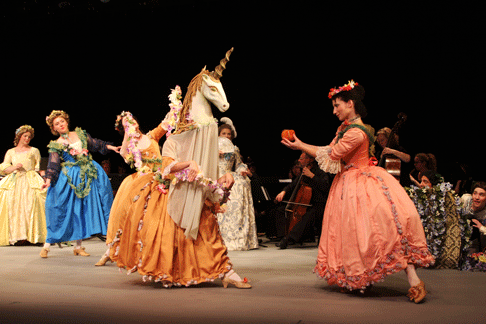All else is, if not irrelevant,
subservient: the look, the style, the star, the archival accuracy. You can pull
any strings you like; just get out there and dance. Or sing.
For instance: You have rehearsed your company of dancers to present a court
opera-ballet of mid-eighteenth century Versailles and you have got the proper
sort of band to play it, and the dancers trained in the proper style, the
graceful mincing steps, half-mime, half-dance, including the sheep and goats
who stalk like sheep and goats with a dainty little waver-step, and attendants
to the wind god who spread their violet cloaks as they leap into the
air—but you have no tenor to sing the title role of the amorous
(and, meteorologists tell us, prevailing) West Wind. Now, Rameau is no
stand-up-and-belt opera composer. Refinement of accent and affect is called for
to put him across. The voice need not—should not—be enormous, but
the clarity of feeling as expressed by melody and ornament and pose are
necessary to make the proper case for his elegant music. These are skills not
often demanded of singers who prepare for opera; they are more suitable to
Early Music singers, happily a far from rare breed in this new era.
So Catherine Turocy’s New York Baroque Dance Company, finding itself
untenored, constructed its production of Rameau’s ZÈphyre around
a soprano, Ann Monoyios, once a reigning diva of the local Early Music scene,
and got around the story’s mythic inconsideration with the announcement
that she was portraying Madame de Pompadour, king’s muse and star of all
the local theatricals in her glory days, as she might have presented a little
Rameau pastorale for a few invited and exalted guests in the little theater at
Versailles. Once that premise is accepted, we don’t even need to dress
her in trousers. She’s in charge, she’s paying the bills, and if
she wants to sing the boy’s part, God bless her.
Monoyios, whom I had not heard in decades, sounds a much younger woman than
she could possibly be. Early Music does not take the toll on the cords that
belting does, and her graceful phrasing, curlicue ornaments at meaningful
times, and truth of character were extremely pleasing on this occasion, if a
dryness did set in by the end of it. Rebecca Choate Beasley, as the object of
her/his affections, did not have much to do but showed a sweet lyric line.
James Richman’s Concert Royal gave sprightly accompaniment.
 Alexis Silver tempting the Unicorn danced by Valerie Shelton Tabor
Alexis Silver tempting the Unicorn danced by Valerie Shelton Tabor
Sets and costumes are half the battle in this sort of entertainment; at
Symphony Space there was no set to speak of, but the company’s costumes
(not credited to any particular designer) accomplished a great deal of
scene-setting. ZÈphyre was preceded by brief dances from several other
Rameau works, including enough mythic animals (unicorns, fauns, gnomes) dancing
in courtly but appropriate style to fill a whole new HBO supernatural
series.
John Yohalem
image=http://www.operatoday.com/Cloris-and-Zephyre-holding-.gif
image_description=Rebecca Choate Beasley as Cloris and Ann Monoyios as ZÈphyre [Photo by Julie Lemberger]
product=yes
product_title=Jean-Philippe Rameau: ZÈphyre
product_by=ZÈphyre: Ann Monoyios; Cloris: Rebecca Choate Beasley; Diane: Lianne Coble. The New York Baroque Dance Company, Catherine Turocy artistic director. Concert Royal, directed by James Richman. Symphony Space, September 22.
product_id=Above: Rebecca Choate Beasley as Cloris and Ann Monoyios as ZÈphyre
All photos by Julie Lemberger